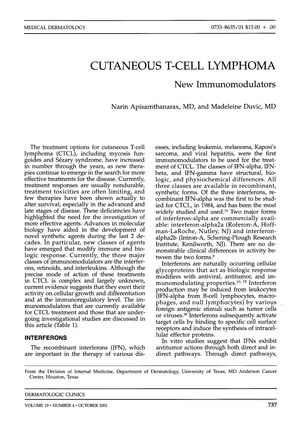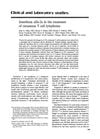Cutaneous T-Cell Lymphoma
October 2001
in “
Dermatologic Clinics
”

TLDR The document concludes that DAB389-IL2 is promising for treating refractory cutaneous T-cell lymphoma, but more research is needed on its effectiveness and side effect management.
The document from October 1, 2001, reviews treatment options for cutaneous T-cell lymphoma (CTCL), with a focus on immunomodulators such as interferons, retinoids, and interleukins. It notes that treatments often have non-durable responses and can be toxic, with few altering survival in advanced stages. IFN-alpha has been used since 1984, showing a 54% overall response rate and a 17% complete response rate, with side effects like flu-like symptoms and potential thyroid dysfunction. Combining IFN-alpha with PUVA may reduce adverse effects. Retinoids like acitretin have a 19% complete response rate and a 58% overall response rate, while the rexinoid bexarotene, approved in 1999, has a 48% overall response rate at 300 mg/m²/day. Topical bexarotene gel has a 44% response rate. Interleukin-2 therapy showed a 43% complete response rate in a small study, and denileukin diftitox, approved in 1998, showed a 30% overall response rate and a 10% complete response rate. Side effects are generally dose-dependent and manageable. The document also discusses DAB389-IL2, a fusion protein targeting the interleukin-2 receptor, which showed a higher response rate at higher doses in advanced disease and a 40% partial response rate in a small study at MD Anderson Cancer Center. The document concludes that while DAB389-IL2 has a role in refractory CTCL treatment, further studies are needed to understand its efficacy and toxicity management, and future immunomodulators could be applicable for CTCL treatment.
